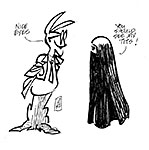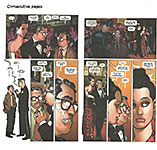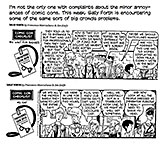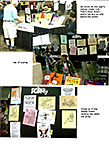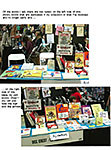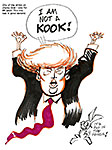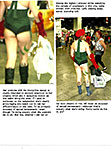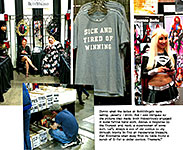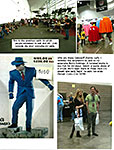 |
|||||||||||||||||||||||||||
Opus 381 (completed June 29, 2018). In the age of the Tyrant Trumpet, it’s easy to understand why an editoonist would be fired for drawing cartoons critical of the Big Boss, but we examine the whys and wherefores at length anyhow. We also analyze the evidence of the Trumpet’s emergence as a tyrant, report on the seventh annual Denver Comic Con, and ponder the burqa-minded Miss America management. And a couple previews of coming attractions. Here’s what’s here, in order—:
EDITOONIST FIRED FOR CRITIZING THE TRUMPET
Trumperies and Editoonery The Emergence of a Tyrant
BURQA BOUND Miss America Removes Swimsuits
BOOK MARQUEE Early DC Comics History with Major Wheeler-Nicholson Eric Stanton & the Bizarre Underground
DENVER COMIC CON
QUOTE OF THE MONTH If Not of A Lifetime “Goddamn it, you’ve got to be kind.”—Kurt Vonnegut Our Motto: It takes all kinds. Live and let live. Wear glasses if you need ’em. But it’s hard to live by this axiom in the Age of Tea Baggers, so we’ve added another motto:. Seven days without comics makes one weak. (You can’t have too many mottos.)
And our customary reminder: when you get to the $ubscriber/Associate Section (perusal of which is restricted to paid subscribers), don’t forget to activate the “Bathroom Button” by clicking on the “print friendly version” so you can print off a copy of just this installment for reading later, at your leisure while enthroned. Without further adieu, then, here we go—:
EDITOONIST FIRED FOR CRITICIZING TRUMP Is This An Omen Foretelling the Future?
Editoonist Rob Rogers was fired June 14. “I blame it on Trump,” Rogers said in the social media message announcing his fate. And he was, in a manner of speaking, absolutely right. He was fired because he was drawing too many cartoons critical of the Trumpet. And his paper, the Pittsburgh Post-Gazette, where he’d spent the last 25 years of his 34-year career as a political cartoonist, wanted to support Trump, uncritically. The week before he was fired, none of his cartoons appeared in his paper. He’d drawn one every day, but the Post-Gazette management didn’t like any of them. Too much anti-Trump. They were all spiked. Then Rogers was, too. As soon as the news of his firing broke, professional organizations immediately voiced their alarm. The number of editorial cartoonists nationwide has been steadily shrinking, and that, in combination with the hostility of the Trumpet to news media, makes Rogers’ firing seem an omen. At least, ominous. The Asssociation of American Editorial Cartoonists, where Rogers had served a term as president, said: “Management of the Pittsburgh Post-Gazette just demonstrated disdain for their readership and lack of concern about declining circulation by firing their cartoonist of twenty five years, Rob Rogers. ... The firing of Rogers and the absence of his cartoons from the editorial pages is a blow to free expression and to the existence of a free and open marketplace of ideas.” (The complete text of the AAEC statement appears at the end of this opus.) Michael Cavan at the Washington Post’s Comic Riffs quoted the National Cartoonists Society. “NCS, which represents hundreds of member cartoonists and other comics-industry professionals, said Thursday in a statement that it ‘is saddened by the news that our friend and fellow member, Rob Rogers, was fired from his longstanding job at the Pittsburgh Post-Gazette. The NCS supports Rob in his efforts to maintain his integrity in expressing his ideas and viewpoint, and stands against any form of censorship or suppression of free speech.’ “The NCS said that Rogers is ‘a very talented cartoonist and we’re confident that he’ll find a new home for his art at a publication that will appreciate his unique gifts.’” The Newspaper Guild of Pittsburgh said that “Rob Rogers is a true talent we were honored to know as a colleague and friend. [He isn’t a member.] He deserved much better treatment.” The Guild said in its statement that the only apparent transgression by Rogers — a past Pulitzer Prize finalist — was “doing his job.” The union also pointed to “the new order of the Post-Gazette editorial pages” reflecting the “pro-Trump, pro-conservative orthodoxy” of the publisher and editorial director. “Given the recent killing of a number of Rob’s cartoons critical of President Trump and conservative positions, favorites of the publisher and editorial director, it perhaps is not surprising that this sad day for the Post-Gazette, the Pittsburgh community and journalism has arrived,” the Guild statement read. Pittsburgh’s mayor, William Peduto, released a statement: "The move today by the leadership of the Pittsburgh Post-Gazette to fire Rob Rogers after he drew a series of cartoons critical of President Trump is disappointing, and sends the wrong message about press freedoms in a time when the press is under siege. This is precisely the time when the constitutionally-protected free press – including critics like Rob Rogers – should be celebrated and supported, and not fired for doing their jobs. This decision, just one day after the President of the United States said the news media is ‘our country's biggest enemy,’ sets a low standard in the 232-year history of the newspaper.” (The complete text of the mayor’s statement appears at the end of this opus.) The Post-Gazette’s readers protested the disappearance of Rogers’ cartoons
the week before the firing, picketing the newspaper’s office. And the paper’s union reporters and non-union editors (who do not enjoy union protection) joined in taking out ads in their own paper distancing themselves from the publisher’s views, which the ads pointedly disavowed. Unprecedented, absolutely. The ads emphasized that the news department of the paper was independent of the editorial department. While the ads didn’t mention Rogers, an accompanying statement did: After describing its members as “shocked” at the termination of Rogers’ employment, the union’s statement continued: “Rogers’ firing has created a firestorm of criticism by readers, many of whom have canceled their subscriptions and have urged others to do so. Readers’ ire also has even been heaped upon newsroom employees because the public does not understand that the staffs of the newsroom and the editorial pages are separate and do not work with each other.” The statement quotes Paula Reed Ward, the paper’s longtime courthouse reporter, saying staffers “appreciate our loyal readers’ frustrations over recent changes on the PG’s editorial page. In fact, we share them. But by canceling subscriptions—or simply not reading—our community members are losing out on quality, independent journalism that is absolutely essential in today’s era of attacks on the First Amendment.” The union president said the number of canceled subscriptions was “significant” and that the paper was “in crisis. They’ve created a mess that we now find ourselves trying to clean up.” “The groundswell of support has been amazing,” Rogers said. “So many readers have been writing, posting, contacting me about this and showing their full-throated support for me and my work. It’s been overwhelming — in a good way. “This has been my dream job,” he went on. “It makes the experience of buying a coffee or checking out at a grocery store a thrill. I go to pay and the person looks at my credit card, sees my name, asks me if I’m The Rob Rogers and then tells me about a particular cartoon he or she loved. The outpouring of support I have received in recent days from the people of this city, including its mayor, has been overwhelming and uplifting. The paper may have taken an eraser to my cartoons. But I plan to be at my drawing table every day of this presidency.” “They got another one of us,” wrote Andy Marlette, son of the late editoonist Doug Marlette. “Rob Rogers drew cartoons critical of the President. So a publisher who puts the American president above American principles (you know, stuff like liberty, individualism and irreverence for government authority figures) fired him last week. First they banned the cartoons — almost 20 in three months. Then they fired the cartoonist. “And not during just any week. It was the same week that our American president smiled and shook hands and played nice-nice with a North Korean man-boy who believes he’s a god-king with a right to torture, starve and murder human beings under his reign. And it was the same week that our American president declared that the press is the nation’s ‘biggest enemy’ — a sentiment shared by the man-boy-god-king who starves, tortures and murders human beings who are under his reign. “So it’s important to remember that this all happened in the same week: An American cartoonist was fired for criticizing an American president who demonizes the press while praising, chumming and posing with a delusional, tyrannical and evil human being. No, it’s not the end of the world. But it is the symbolism, stupid.”
NO, IT’S NOT THE END OF THE WORLD. The Rogers firing is a dramatic instance of the fundamental conflict that infects the editorial cartooning profession. Editoonists express opinions about the events of the day, mostly political events. Historically, if a cartoonist’s opinions did not match those of his editor and publisher, he would soon be looking for another job. But in the last 20-30 years, that changed. Editors still approve editorial cartoons for publication, but most editors regard their editoonist as another opinionated voice on the editorial page, and even if they don’t agree with the cartoon, they agree with the principle that differing opinions have a place on the editorial page: the cartoonist should be permitted to voice his opinion. And so they publish the cartoons, whether they agree with their opinions or not. The Rogers firing is thus alarmingly out-of-step with current practice. It represents a return to the olden days, the days of autocratic (fascist?) management. But there is about this firing a malevolence that points to a larger issue. This is not about freedom of the press. According to the axioms of journalism, freedom of the press belongs to those who own one. Publishers. Nor is it about censorship, as Rogers himself realizes. He has made clear the distinction between the editorial stifling of his views and the harsh legal action against political critics that occurs in some countries: “It’s not the same as being thrown in jail for drawing the president,” Rogers said. “That has not happened, and that would be real censorship, and it does happen in other countries. I don’t want anyone to get the wrong assumption here.” Regardless of terminology, Rogers still said the issue is of great concern, and indicative of a greater trend in this country: “As I’ve said to some people, I’ll be fine, but the city won’t be fine if we lose this paper, if this paper continues down this road. In the same way the country won’t be fine if more outlets are shuttered or somehow their voices are silenced.” If the Trumpet succeeds in silencing voices of dissent because they say things he doesn’t like, then freedom of the press is over. And that is what is in the minds of other editorial cartoonists— David Fitzsimmons at the Arizona Daily Star in Tucson, Joel Pett at the Lexington Herald-Leader, and Ann Telnaes at the Washington Post. We’ll take a look at what they said in the paragraphs below.
DAVID FITZSIMMONS wrote the day after he heard that Rogers had been fired on June 14; herewith—: According to the Columbia Journalism Review, “Since March, the Post-Gazette has nixed 19 ideas for or drafts of cartoons by Rogers, and has withheld six of his cartoons from publication since Memorial Day. The first of those six, drawn for Memorial Day, depicts President Trump laying a wreath before a burial marker that reads ‘Truth, Honor, Rule of Law.’” Like most of his work, it’s an incisive, profound and beautiful cartoon. [Nearby, I’ve posted all six of the cartoons that the newspaper killed after they’d been drawn and submitted.]
Rob’s nightmare began when Block Communications, the owner of the Post-Gazette, promoted a Trump disciple, Keith Burris, to the position of communications vice president, editor, editorial director. “MAGA propaganda minister” would be a more precise title. The first clue the Post-Gazette was radically shifting appeared in January when Burris penned a bizarre editorial, “Reason as Racism.” It was panned by readers as the intellectually disingenuous work of a Trump apologist. The Newspaper Guild of Pittsburgh called the piece “extraordinary in its mindless, sycophantic embrace of racist values and outright bigotry espoused by this country’s president.” In the CJR piece I cited earlier, Rob says, “A political cartoonist is meant to be provocative, and is meant to cover people in power and keep those people accountable. When I was hired by the Post-Gazette 25 years ago, it was to come up with my own ideas and draw those ideas, not to be an illustrator of someone else’s ideas.” As the President’s ratings creep up, the lickspittles in Congress line up to kiss Trump’s ring, the right-wing media machine beats its mighty chest and the President’s satirical critics are hammered, I wish the talented Mr. Rogers continued success in spite of the terrible challenges ahead. The same goes for our democratic republic.
THE “REASON AS RACISM” editorial was published in January and was a harbinger of things to come. Here’s the Columbia Journalism Review’s report—: In early March, Block Communications—an Ohio-based media company that owns the Toledo Blade and the Pittsburgh Post-Gazette—merged those newspapers’ editorial page operations and appointed Keith Burris to lead them. The two papers would share the same editorial page—“an effort that, to my knowledge, has never before been tried in American journalism,” wrote Burris, who previously edited the Blade’s editorial pages. “For all of us, this is going to be fun.” Many readers in Pittsburgh disagree. Burris’ appointment comes after an unsigned editorial, published in both papers in January, roiled readers in both cities and drew pointed criticism in Pittsburgh—from current and former Post-Gazette newsroom employees, community foundations, members of the publisher’s family, and other journalists. The unsigned “Reason as Racism” editorial appeared first at the Blade and then ran in the Post-Gazette on Martin Luther King Jr. Day. (The papers have previously run each other’s editorials from time to time.) The editorial cautioned that charges of racism are “the new McCarthyism,” and argued for the “need to confine the word ‘racist’ to people like Bull Connor and Dylann Roof.” According to the editorial’s rationale, “racist” cannot function as a useful, evidence-backed descriptor, but only as “a term of malice and libel.” The Newspaper Guild of Pittsburgh attributed ultimate responsibility for the editorial to publisher John Robinson Block, who previously asked that Post-Gazette staff scrub President Donald Trump’s “shithole countries” comment from an AP story slated for the front page. A week later, Burris was identified as the author of the unsigned editorial, which he defended in a subsequent column. “What happens if you ‘think outside the box,’ about matters of identity conviction, elevated to an almost theocratic level?” asked Burris. “You get called out. You get called a racist yourself, and maybe even, for good measure, homophobic or misogynistic.” A week after that, he appeared to call for a return to a more faith-based society in a piece that also blamed “the 1960s and feminism” for what he views as today’s “coarse culture.” Feminism, wrote Burris, “was a step back toward barbarism, not away from it. It is a ridiculously inconsistent ideology: Let us be feral but victims too.” And three days after the “Reason and Racism” editorial ran, the Block family — relatives of the publisher — wrote to disavow the editorial: “Since 1927, our family has been involved with the Post-Gazette, shaped primarily by the nearly six decades of William Block Sr.’s socially conscious leadership,” the response said. “The editorial ‘Reason as Racism,’ published on Martin Luther King Day, printed without the Post-Gazette editorial board’s consensus, and attempting to justify blatant racism, is a violation of that legacy.”
JOEL PETT, editoonist at the Lexington Herald-Leader, joined Fitzsimmons in a scathing critique of Rogers’ firing. Active in protesting the abuse of cartoonists worldwide as an official in the Cartoonists Rights Network International, Pett began with references to the plight of cartoonists in other, “less enlightened,” countries—: A cartoonist is jailed. Another is charged with treason. A cartoonist disappears. Another is threatened by government goons. Throngs march against a perceived cartoon’s slight. That’s how it goes among CRNI clients around the world, but not here. In corporate America, cartoonists merely lose their livelihoods. I’m not comparing unemployment to incarceration, but with those livelihoods go the paychecks, the health care, the secure retirements, the legal protections, and a lot more. Strident, no-holds-barred newspaper editorial cartooning, spiraling into inexorable death throes for at least two decades [the number of full-time staff editoonists in the U.S. has dramatically declined from about 100 in DATE to about 50 today], bleaches into a pile of bones on a changing media landscape, all due to uncertain advertising economics, right? But what if it’s worse? What if losing our jobs is more than a lamentable byproduct of the well-documented industry convulsions that have also sidelined armies of shoe-leather reporters, photographers, copy editors, art critics, columnists, and on and on? What if editorial cartoonists were not just victims of economic hard times, but unabashedly discarded for challenging the country’s leadership and direction? And what if this happened to mainstream cartoonists, at big-city dailies, during an administration which has expressed admiration for thug regimes around the globe and promoted policies akin to tin-pot dictatorships?
AND ANN TELNAES, another Past Prez of the AAEC (also a Pulitzer winner and a winner of thke NCS Reuben Award, the only woman cartoonist to win both), chimed in with thoughts along the same lines—: I realize now I didn’t recognize this other danger of an authoritarian president: his enablers and the willing supporters who squash dissent and help attack the free press and subvert the Constitution. The fact that Trump will use any opportunity to spread lies and whip up hatred toward journalists only enables his powerful supporters in the media to do his dirty work for him. In April, another disturbing example of journalistic manipulation was exposed when a video surfaced showing news anchors from 45 Sinclair-owned stations reciting word for word the same script criticizing the mainstream media and spouting the “fake news” accusations that Trump uses in his diatribes. While Trump used the opportunity to blast its critics and offer his support for the “superior” Sinclair Broadcasting, he hadn’t orchestrated this abuse of journalistic integrity. He didn’t have to; there were others willing to do it for him. ... Through satire, humor and pointed caricatures, editorial cartoonists criticize leaders and governments that are behaving badly. The purpose of an editorial cartoonist is to hold politicians and powerful institutions accountable — and we all know how little President Trump thinks he, his family or his sycophants should be held accountable. Rogers was the first American editorial cartoonist to lose his job as a result, but he won’t be the last. Trump has many “fixers.”
CNN’s JAKE TAPPER spoke to Rogers on “The Lead” (June 6) about the dearth of Rogers cartoons during the first week of June. When CNN reached out to the Post-Gazette for comment, a representative responded: “This is an internal, personnel matter we are working hard to resolve. It has little to do with politics, ideology or Donald Trump. It has mostly to do with working together and the editing process.” Rogers, however, said he didn’t buy that explanation. “It’s clear from the cartoons that have been killed that it’s more than just about a personnel issue,” he said. “When you have a record number of cartoons killed and 90 percent of them are about Trump, something’s happening.” As far as the Post-Gazette “working hard to resolve” the issue, Rogers said he has yet to hear from them about any progress. But for the week before his firing, he took personal days off and sent in no new cartoons, hoping a low profile would lead to a good outcome. Rogers said he feels the opinions of the Post-Gazette’s executive powers are beginning to change the content of the paper. “My views have always remained the same,” Rogers said. “I’ve always been a left-leaning cartoonist that tries to be provocative and be funny and do the best work I can do. The page is changing. Not because of me. And I feel that they want an illustrator who will reflect the views of the publisher.” However, he said, citing Fox News, Sinclair Broadcasting and even the yellow journalism of the past, news outlets pandering to particular ideologies is not uncommon. “There’s been a proud tradition of publishers putting their heavy hand on the scales of opinion in their page and slanting it,” Rogers said. “They have every right to hire whoever they want or fire whoever they want, but they don’t necessarily have the right to tell me to change my views in the process.” Rogers said he was given no explanation as to why the six most recent cartoons weren’t published. “Basically, communications broke down,” he said. In the past, he said, the editorial process had felt freer and more collaborative. Rogers has been a cartoonist for the Post-Gazette since 1993. For many years, he would simply submit the cartoon and it would appear in the paper, but in the past decade, he began sending emails to his editors for their approval of what he planned. Under this system, he said, he had only a few cartoons spiked each year. Since March 2018, however, when Burris took over the editorial director position of the Post-Gazette, 19 of Rogers’ cartoons have been killed: “Up to the time the new editor came on board, I had only 2–3 cartoons a year killed, and they were usually for issues of taste, or that I maybe had, in their minds, pushed the boundaries too much. Once in a while, if they would kill one, I could talk to them and tell them why it was important, and what was behind the idea, and they would sometimes change their minds.” But that’s changed since the enthronement of Burris. Burris, like publisher Block, is a Trump supporter. “I think he came with the intention of changing over the page like he did in Toledo,” Rogers said. “When he came, since that time, I’ve had 19 cartoons or ideas killed.” Of the 19, nine were rejected while in the rough sketch stage; the remaining 10, like the 6 killed since Memorial Day, were finished art. One, the KKK Ambien cartoon, was yanked after it had been dummied onto the page. Rogers recalled some of the cartoons spiked before the reign of Burris, on topics including the Catholic Church, reproductive rights or U.S. involvement in Afghanistan. But never, Rogers said, have so many cartoons depicting a single person been rejected. Though some of Rogers’ cartoons satirizing Trump have run in previous months, most of his recently killed cartoons were about the President—on topics ranging from Stormy Daniels to the Mueller investigation to the Trump’s attacks on the FBI.
AT THE DAILY BEAST, Lloyd Grove summarized the situation—: Block is the scion of a century-old media dynasty founded by a Lithuanian-Jewish rag picker’s son who landed at Ellis Island and eventually did business, and shared a mistress, with William Randolph Hearst (the silent-film star Marion Davies). In an interview over the weekend with Politico conducted as Block attended a class reunion of his posh prep school, Hotchkiss, in Lakeville, Connecticut, he claimed Rogers was relieved of his five-cartoon-a-week duties out of concern for his well-being. “He’s just become too angry for his health or for his own good,” Block said. “He’s obsessed with Trump,” he went on, arguing that it’s a newspaper cartoonist’s obligation to hew to the editorial positions of his publisher—at best, an eccentric take on the job—and adding: “I wanted clever and funny instead of angry and mean.” According to Tom Waseleski, the Post-Gazette’s former longtime editorial-page editor, Block participated in editorial board meetings that became increasingly testy in late 2015 and early 2016 as the publisher defended Trump against the criticisms of his editorial page staff. “John was trying to position us for a possible Trump endorsement before Pennsylvania’s Republican Primary,” Waseleski recalled. “By the fall of 2015, he was showing a lot of fascination with the candidacy of Donald Trump, and the meetings of the editorial board became very fractious. We did a lot of arguing and there were a lot of disagreements.” Waseleski recalled being summoned to a nighttime January 2016 meeting in the publisher’s office. “He said, ‘I want you to begin turning the views of our editorial-board members and our editorial positions more toward the direction of Donald Trump,’” Waseleski recounted. “And I said, ‘John, that’s totally backward, because we espouse the positions that we have had over the years, and those positions should direct us toward the candidate we eventually endorse in a presidential race.’ And he said, ‘You need to think about doing that because we may be making an endorsement of Trump in the Republican primary.’ And I just flat-out said, ‘John, I can’t do that for you.’” In the end, Trump won the April 26, 2016 primary in a landslide, even though the Post-Gazette—in a departure from tradition—didn’t ultimately make an endorsement. By that time, Waseleski—finding his position at the Post-Gazette increasingly untenable—had already taken a buyout and left the paper for which he’d been toiling since 1983. “Rob is not consumed by anger,” Waseleski said about the cartoonist. “He is very funny and very topical. I always joked with him that I was the adult in the room and he’s sort of like the prankster teenager, and we appreciated that relationship. Every once in a while I would throw a caution flag if he went overboard a little bit. But his firing is a great loss to the Post-Gazette and to opinion journalism. Even if the publisher had strong disagreements with him about Trump, he should have kept him on. The publisher certainly had other ways to push his views in the paper.” Rogers said that John Allison, Waseleski’s successor, occasionally communicated the publisher’s distress with the sharp pin-pricking of the President in his cartoons, but did little to rein him in during the first year of the Trump administration. ... During a getting-to-know-you lunch in mid-March, Rogers recalled, Burris advised him to decrease the frequency of his Trump japes, and told him that John Block wished him to draw cartoons that scrupulously reflected the editorial positions of the publisher. “I said, ‘That’s news to me, and I do not believe that,’” Rogers recalled. “I have always drawn my cartoons without any concern about my political viewpoints, and while I have certainly been edited, I’ve never been told ‘you’re too liberal.’ If something was killed, it was usually because of taste, or it wasn’t quite accurate or ‘you’re going too far.’ It was never because ‘your politics are different from ours.’” “We tried hard to find a middle way, an accommodation to keep him at the paper,” Burris insisted. “We never said he should do no more Trump cartoons or do pro-Trump cartoons. For an in-house staff cartoonist, editing is part of it. Rob’s view was, ‘Take it or leave it.’” Burris told Kim Lyons at nytimes.com that while he may be more to the right than Rogers, his goal is to make sure the Post-Gazette is “independent and thoughtful” in its approach, without any ideological intent. “I’m certainly not in Trump’s base and I don’t think our publisher is, we just don’t think he’s Satan,” Burris said. “We never said ‘don’t do Trump cartoons.’ A Trump cartoon every day is not interesting, and a Trump cartoon every day that’s not funny and is just enraged is not particularly effective.” On the Post-Gazette’s editorial page the day after Rogers’ firing, a statement attributed to the editorial board professed “gratitude and affection” for Rogers. The statement then went on to support Burris’ version of events: “There has never been any intention to silence or suppress Rogers. Nor would we ever ask him to violate the dictates of his conscience. Rather, we have sought to engage in the necessary journalistic practices of editing, gatekeeping and collaboration.” In the Post-Gazette article about the firing, Burris said that when he came to Pittsburgh in March, he met Rogers for lunch and told the cartoonist, “Obviously, we don’t think that Trump is the worst president in history.” “It was an agonized conversation on both sides,” said Burris. After that, wrote Joyce Gannon for the paper, the two exchanged frequent emails about Rogers’ cartoons in which Burris said he was trying to address “the tone and frequency” of Rogers’ drawings about Trump. “I asked for broader topics and could they be funnier?” Burris said. Rogers’ version of events is severely at odds with Burris’. He told Grove at the Daily Beast that he regularly emailed his cartoon ideas to Burris, and was open to his input, but frequently received zero response, leaving him to forge ahead—in his second-floor home studio in Pittsburgh’s hipster Lawrenceville neighborhood—without guidance. Often, Burris—or Block—would kill his cartoons at the last minute.
After the embarrassing hiatus during which the Post-Gazette published no Rogers cartoons, the paper published one final Rob Rogers cartoon dated June 5; it illuminated the folly of the Trumpet’s trade war with Canada, Mexico and Europe.
THE SAME DAY, Rogers was summoned to the paper’s HR office and handed a document, apparently concocted by Block and Burris. It suggested that he could stay at the paper, Rogers recalled, if he let his two bosses closely collaborate on his cartoons, essentially allowing them to dictate the content. “That was a non-starter,” said Rogers, who added that he responded with a respectful explanation of why the arrangement would not work. He didn’t hear back, he said, until a week later when he was summoned to the offices of Cowden Associates, the paper’s outside personnel consultants. Said Rogers: “They said, ‘This is your last day.’ It was like those movies you see on tv where the cop has to hand in his badge and his gun, only I was afraid they were going to ask for my pen.” He said he was handed a severance agreement to sign which required him—in return for six months’ pay—to agree to a tartarean nondisparagement clause that essentially muzzled him about the events and people that led to his firing, and to transfer the ownership rights to the paper for all of his Post-Gazette cartoons over the past quarter-century. To add insult to injury, Rogers said, the severance agreement offered a freelance deal in which he would be required to come into the office and draw cartoons—after close consultation with his bosses—and receive $100 for each, with the paper, of course, retaining ownership rights. “It was draconian set of guidelines that would made my life more miserable, even more so than it had been under the new editor [Burris],” Rogers said. And the pay, $100 for each cartoon, was miserly. Now, Rogers said, he is exploring offers of paid work, and will likely be able to benefit from the family health-insurance plan of his life partner, University of Pittsburgh art gallery director Sylvia Rohr. And, as long as the Post-Gazette doesn’t file an objection to his unemployment insurance, he said he has no plans to sue the paper or its executives. Whatever happens, Rogers will continue cartooning. “The goal is figure out what it is that sort of hits you in the stomach,” he explained. “I don’t want to use the word ‘angry’ because somebody might accuse me of being too angry. It’s something that gets your goat, that makes you say to yourself, ‘This is unacceptable, this is unjust, and I need to draw something about this.' In the Trump era, it is often Trump.” Encouraged by reader reaction, Rogers continues to post his cartoons on his social-media accounts, and they continue to be distributed by his syndicate, Universal Press. Rogers said the editorial chief of Universal has instructed the accounting department to pay him—“for the foreseeable future”—100 percent of the royalties instead of just his half of the usual 50/50 split. At the latest report, the Pittsburgh Current (which may be an online newspaper rather than print— and maybe it’s moving to print—dunno) picked up Rogers cartoons. And at his Facebook page, Rogers told some 2,300 “listeners” that he was thinking of starting a Patreon site.
“I BLAME TRUMP,” Rogers wrote the day after he was fired. He continued—: Well, sort of. I should’ve seen it coming. When I had lunch with my new boss a few months ago, he informed me that the paper’s publisher believed that the editorial cartoonist was akin to an editorial writer, and that his views should reflect the philosophy of the newspaper. That was a new one to me. I was trained in a tradition in which editorial cartoonists are the live wires of a publication — as one former colleague put it, the “constant irritant.” Our job is to provoke readers in a way words alone can’t. Cartoonists are not illustrators for a publisher’s politics. When I was hired in 1993, the Post-Gazette was the liberal newspaper in town, but it always prided itself on being a forum for a lot of divergent ideas. The change in the paper did not happen overnight. From what I remember, it started in 2010, with the endorsement of the Republican candidate for Pennsylvania governor, which shocked a majority of our readership. The next big moment happened in late 2015, when my longtime boss, the editorial page editor, took a buyout after the publisher indicated that the paper might endorse Mr. Trump. Then, early this year, we published openly racist editorials. Things really changed for me in March, when management decided that my cartoons about the President were “too angry” and said I was “obsessed with Trump.” This about a President who has declared the free press one of the greatest threats to our country. Not every idea I have works. Every year, a few of my cartoons get killed. But suddenly, in a three-month period, 19 cartoons or proposals were rejected. Six were spiked in a single week — one after it was already placed on the page, an image depicting a Klansman in a doctor’s office asking: “Could it be the Ambien?” After so many years of punch lines and caricatures, skewering mayors and mullahs, the new regime at the Post-Gazette decided that The Donald trumped satire when it came to its editorial pages.
THE PROBLEM FOR THE WRITER, Ernest Hemingway told a meeting of the Writers’ Congress in 1937, is always the same: how to tell the truth. He opposed Fascism because it “is a lie told by bullies. A writer who will not lie cannot live and work under fascim.” Neither can an editorial cartoonist.
“WHATEVER HAPPENS,” Rogers said, “my plan is to continue to try to draw the kind of cartoons that I think are needed today, especially today, in this climate when there are attacks on the news media, attacks on free press, when there’s abuse of executive power. I think it’s especially important now to use cartoons and satire to afflict the comfortable. “As I look back on my career,” he said elsewhere, “I am more awed by the kind of cartoons my newspaper allowed me to draw than the ones they rejected. For decades, the Post-Gazette had the courage to print edgy, controversial cartoons that pushed the boundaries and really made readers think. They defended the work and stood behind me. I will always be grateful and humbled by that.” And now, Rogers continued, “I wake up every morning excited to fight the good fight, to afflict the comfortable, to speak truth to power, and, yes, to make people laugh. I love my job. I just want to do my job.” In another statement, Rogers said: “I fear that today’s unjustified firing of a dissenting voice on the editorial pages will only serve to diminish an opinion section that was once one of America’s best. I love what I do and will continue to find ways to do it and get it out there. The world needs satire now more than ever.”
AND ERIC B. LIPPS at nytimes.com agrees—: Gagging editorial cartoonists may not seem like the worst possible threat to a free press, but as Rob Rogers, the cartoonist fired by the Pittsburgh Post-Gazette, makes clear, it’s still a threat. Editorial cartoons often express viewpoints contrary to those of a publication’s editors. If anything, they are equivalent to op-ed articles. When a cartoonist is censured, or fired, for using his creations to express ideas his employer doesn’t like, or that his supervisor thinks that the boss won’t like, the message is clear: your job is to be a mouthpiece, not to express any opinions of your own. And if cartoonists can be bullied in this way, what’s to protect actual op-ed columnists, or reporters, from the same treatment? For that matter, what’s to protect their editors, if they don’t go along with their publishers and punish those who step out of line? And punishing people for making fun of politicians is particularly insidious, for it protects those politicians from criticism that might save them from making destructive decisions. In an age when many countries are armed with nuclear weapons and the means to deliver them to distant targets, and when countries ruled by people like President Trump’s new friend, Kim Jong Un, are among them, this is an urgent matter.
THIS EFFECTIVELY ENDS THE ESSENCE of the Rancid Raves report on Rob Rogers’ firing. In our next Harv’s Hindsight, we’ll publish a long interview Harv conducted with Rogers in DATE, just as background. At the end of this opus, we’re appending a Q&A Rogers participated in, covering some aspects of the current situation in more depth. After the Q&A, we’re posting the complete texts of the AAEC statement and the statement of Pittsburgh’s mayor. Between here and there, we have some Trumpery and a report on the Denver Comic Con.
TRUMPERIES In place of our usual Editoonery Department this time, we’re shortening the topic to just the Trumpet and his Trumperies. Fact is, it’s difficult to find any considerable number of editorial cartoons these days that aren’t about the twitterpated Trumpet. He so dotes on the attention and is so insistent in claiming the spotlight every day that editoonists surrender to the inevitable and draw another picture of his flaxen hair-do and his lippy mouth and his looooong red tie. Just the picture alone is hilarious. And so, until lately, is Trump, I thought. I saw him as a deluded buffoon, too much in love with himself and too vulnerable in his insecurities. Every time this creature did something or twitted something, it was, almost by definition, laughable. But I no longer think that. Lately, the awful dimensions of Trumpery have emerged. And they are frightening.
THIS IS A MAN WHOLLY IN THE EMBRACE of his own high opinion of himself. For his first year in the White House, the Trumpet was a little insecure, hesitant. After all, he knew nothing about Washington politics. In fact, he knew nothing about anything except reality tv. And so he surrounded himself with friendly but still knowledgeable politicians and operatives. But over the ensuing months, he learned that this cadre of advisors were all, like Washington politicos generally, timid invertebrates, postponing decisions and actions until they were certain the political winds were blowing favorably in their direction. Trump learned that he could do pretty much whatever he wanted to do, and the consequences—the immediate consequences—were negligible. He wouldn’t be hurt much. (To hell with other considerations—like whether others might be hurt or the reputation and standing of the U.S. would suffer.) And so he fired most of his knowledgeable staffers and started anew in his second year with an entirely off-the-cuff regime, departing from the timid, the cautious. The Week outlined the new dimensions of Trumpery under the heading “Trump: Has the GOP Become a Personality Cult?” The article continues—: The proof keeps pouring in, said Jonathan Chait in NYMag.com: “The Republican Party is devolving, at an accelerating speed, into a cult of Donald Trump.” ... The propagandists over at Fox News have been plumbing new depths of Orwellian dishonesty in the service of the Dear Leader. Not only do Fox anchors daily echo the president’s baseless conspiracy theories about the Deep State and Bob Mueller’s “witch hunt,” but the network even attacked GOP Senator Marco Rubio for the heresy of criticizing North Korea’s Kim Jong Un, the vicious dictator upon whom Trump is suddenly “lavishing praise.” (And the lavishing is working for Kim, saith The Week: in the wake of the recent summit with Trump, Kim Jong Un now boasts a higher “favorable” rating among Republicans—19 percent—than does House Minority Leader Nancy Pelosi—17 percent.) The Week continues to elaborate on the Trump cult: Republican voters simply shrug off blunders and scandals “that would have doomed prior presidents,” said David Weigel in WashingtonPost.com. As Republican Senator Bob Corker put it, “It’s becoming a cultish thing, isn’t it?” It sure is. With a staggering 90 percent of Republicans now approving of the President’s job performance, one of our major political parties is now united “not by fealty to ideas or policies but to a man.” ... Despite some overlap, Trumpism isn’t really conservatism, said Jay Bookman in the Atlanta Journal-Constitution. Republicans used to stand for free trade, family values, fiscal conservatism, limited government, and strong international leadership. Today, “the principles of the Trump party are defined by whatever it is that Trump tweets next.” That may be true of the large mass of low-information voters, who rally around Trump out of “group solidarity,” said Noah Rothman in CommentaryMagazine.com. ... Trump, The Week continues, has a cult leader’s talent for reshaping reality to conform to “his delusions,” which he insists upon “with extraordinary energy and stamina.” Many Republicans have simply lost interest in the ideas and principles that our politics used to be about, and have joined Trump in his “ludicrous reality show,” where the truth is whatever he says it is. They’re for whatever he’s for,”even if that means changing their minds on a dime.” Among Republicans, at least, Trump’s strength is growing. “The more people who call the emperor clothed, the harder it is to see him naked.”
WE SEE EVIDENCE of the Trumpet’s soaring opinion of himself everywhere we look. At the conclusion of his summit with Kim Jong Un, he announced his satisfaction: America and the world can “sleep well tonight,” he said, declaring that his meeting with Kim had ended any nuclear threat from North Korea—although the meeting produced no details on how or when weapons might be eliminated or even reduced. (Another of the summit’s accomplishments, the only one: Trump made unnecessary concessions to Kim that Kim did not return in kind.) Incidentally, according to TheHill.com on June 27, satellite images from the previous week show that North Korea is making numerous improvements to the infrastructure at a nuclear research facility. So much for our sleep. Spanky will, of course, deny this outcome. Fake news, he’ll say. No matter. “Just landed,” Trump tweeted upon his return to the U.S., “—a long trip but everybody can now feel much safer than the day I took office. There is no longer a nuclear threat from North Korea. Meeting with Kim Jong Un was an interesting and very positive experience. North Korea has great potential for the future.” Thanks to His Magnificence as Deal Maker and Leader of the National Delusion, we can all sleep easier. Wonderful. But that’s not all the Trumpet learned during his confabulation with Kim. During a Fox News interview, Trump marveled at Kim’s power: “He speaks and his people sit up at attention. I want my people to do the same.” “My people”? We’re Americans. We’re nobody’s “people.” Only kings and other autocrats and outright dictators speak of citizens of their countries as “my people.” Trump clearly sees himself in that company. And
the Trumpet’s monarchical ambitions immediately attracted the attention of
editors at Time and The Week, who produced covers for their
magazines that served as political cartoons, expressing the publishers’ scorn
for Trump’s outlandish ambitions. Despite the ridicule on the covers of the nation’s magazines, the Trumpet’s attitude persists. Since he has no sense of humor, he is immune to political cartoons like those on these magazine covers. Comedic ridicule has no effect on him. He still thinks of himself as a king. We are “his people.” And so he goes about the business of his monarchy as he imagines it, offending other world leaders, thereby effectively unraveling an international network of mutual interest that has been carefully constructed and nurtured over the 70 years since World War II. Its object: to make nations so interdependent that none will want to make war ever again because war would undermine their economies. Trump is clearly a dangerous man. He is a threat to democracy at home (attacking free press and an independent judiciary) and abroad, where he threatens world peace by sneering at other countries and their leaders. At the very least, Trump has provided a stark new axiom that other countries cannot depend that American policy will remain constant from one president to the next. And that is devastating to America’s future in the world. And perhaps to the world’s future as well. Trump is on the cusp of becoming a tyrant. In his so-called mind, he already is one, an absolute ruler of all he surveys. “The man has a real genius for pretending to be real,” said humor columnist Will Durst. But the pretense has become an active menace.
AS WE SEE FROM THE PRECEDING VISUAL AID, Time wasn’t finished with His Majestic-ness. Two weeks after the King Me cover, the Trumpet’s policy separating families that crossed the southwest border illegally was the subject of the cover. And The Week chimed in, too. Both covers acted, again, as political cartoons. But the cover cartoons were gentler than Margaret Talbot at the New Yorker (July 2), who wrote: “The theatre of cruelty unfolding at the southern border last week was the purest distillation yet of what it means to be governed by a President with no moral center. ... Trump insisted that only an act of Congress could stop the separations, and that the Democrats were to blame. The secretary of Homeland Security, Kirstjen Nielsen, claimed that separating parents and children was not a policy—she was imply following the law. All of this was false as became obvious on Wednesday, when Trump signed an executive order revoking the policy that he’d said he could do nothing about and that Nielsen said didn’t exist. “It would be nice to attribute this change of plans to a genuine change of conscience, but, in signing the order, Trump was transparently angry at being compelled to do so. He said, ‘If you’re really, really pathetically weak, the country is going to be overrrun with millions of people, and if you‘re strong then you don’t have any heart. That’s a tough dilemma. Perhaps I’d rather be strong.’ ... “It will be important,” Talbot concluded, “to be on guard for what this Administration may try next.” One of those on guard is Washington Post syndicated columnist Catherine Rampell. She wrote: “It’s all a hoax. A great big hoax. Not the family separations, the babies alone in cages, the drugged immigrant children, the stolen toddlers too traumatized to speak, the wailing children whom Ann Coulter slanders as ‘child actors.’ “Sadly, those cruelties are all too real. “The hoax is the premise that President Trump’s administration has invented to rationalize such crimes against humanity: his narrative that American has been ‘infested’ with hordes of crime-committing, culture-diluting, job-stealing, tax-shirking benefits-draining ‘aliens.’ “No part of that description is remotely true.” She goes on to refute every allegation, one after another, with contradictory statistics.
THE NATION’S
EDITOONISTS took up the subject. Next around the clock, Bill Day’s metaphor of Spanky the Trumpet with pie on his face (it could have been egg but pie-in-the-face makes it vaudevillian comedy, an accurate interpretation) bluntly proclaims the gaffe the Prez committed in conspiring with Attorney Jeff Sessions to “enforce the law” by imprisoning illegal adult immigrants and separating them from their children, who, perforce, were not “guilty” of any law-breaking and should not, therefore, be imprisoned. Instead, they were ripped from the arms of their parents and detained at other facilities, some of which were thousands of miles away from where their parents were incarcerated. Bill Schorr offers “Trump’s Guide to Border Security,” sarcastically identifying the “rapists, murderers, and drug gangs” that the Trumpet’s policy is putting behind bars—er, or in wire cages. And then Kevin Siers shows how the Spanky has successfully extricated himself from the dilemma: he made it himself, and so he gets himself out of it. He started the fire; and he’s stopping it, too. The medal on his chest proclaims him a hero, but his contradictory handfuls suggest something else: sheer thoughtless bumbling and chutzpah unequalled. Jeff
Sessions stars in the next display. Being strong, the Trumpet says, is key to having a country. You can’t have a country without effective borders. And he has, indeed, as Tom Toles shows us, amply demonstrated what “appearing” to be strong consists of: kicking little kids. Ah, what power. What strength. Joel Pett at the lower left compares Spanky’s dreams to the ones he’s so far shattered, deploying the comic strip form to list the Trumpet’s dreams/accomplishments. The last panel is the switch in this bait-and-switch: we aren’t expecting Trump’s nightmarish accomplishments to be termed (as he does) “dreams.” Returning
in our next visual aid to the Trumpet’s international successes, we have Tom
Toles screening a how-to video from Kim to Spanky that extols the benefits
of a dictatorship, something to which, as we’ve seen, Trump aspires. Next around the clock, Adam Zyglis gives us the tyrant Trumpet demonstrating his prowess. The cartoon recalls a famous Trump utterance to the effect that he could stand on Fifth Avenue and shoot someone and none of his followers would object. Here, Spanky has killed the Iran Deal, the Paris Accord in Climate, and TPP (Trans-Pacific Partnership), thereby demolishing U.S. Credibility. But, as Trump himself observes, “Nobody cares.” Not now maybe, but ...
TRUMP IS KNOWN TO FAVOR two-party negotiations rather than multi-party negotiations, and that’s why he has exited those multi-nation agreements. Why? What is so appealing about two-party agreements? Simple. In two-party negotiations, there are only two parties to please; in multi-party negotiations, all parties must be pleased. That usually means that what they agree to, finally, is a fairly tepid proposition—after all, everybody must agree to it. Two-party negotiations result in somewhat stronger outcomes because there are fewer parties that must agree. But two-party negotiations offer another advantage. Usually there’s a third party on the fringes, eager to become involved. The negotiator can play one party against another, one at a time instead of in a group as with multi-national agreements. First, you negotiate with one of the parties you hope to make an agreement with; then you negotiate with another of the parties. And you say to the second: Hey, this other country has agreed to X; so don’t you want to do us better than X? Don’t you want to go to Y in order to get our business? And then, after securing the second party’s agreement to Y, you go back to the first party and tell them: Listen, the other country has upped its ante to Y rather than just X. Don’t you want to do better than that? Back and forth, one at a time, you play one against the other and get a much better deal than you’d get if you sat at a table with half-a-dozen parties, all trying to agree on something. And the something they’d all ultimately agree to would be something less than you might achieve by working one against another. Two-party negotiations favor the bully (that’s why Trump likes them). The stronger of the two parties usually wins; the other party must be content with whatever it’s forced to concede to. In multi-party negotiations, everyone begins in a spirit of compromise. They are all willing to be compliant, to take what they can and not insist on some advantage. The Trumpet wants to re-do the TPP pact (and the others). He’ll go from one of the partners to the next, one at a time, playing one against the other until he gets a somewhat improved outcome for the U.S. Multi-party negotiations have become popular since World War II because their agreements, however frail they may be, tend to bind the parties together. Bound together, nations do not usually seek to go to war with their partners. Back
to our exhibit, we have Lalo Alcaraz celebrating Father’s Day with an
unsubtle portrait of Spanky as the Fuhrer of legend and history. Trump’s not
there yet. But we can’t say with Finally, as a closing treat for today, we have a selection of Mike Peters’ portraits of the Trumpet. I’ve somehow overlooked Peters’ editoons through the years. His work just isn’t collected at any of the places I look. And I’m the poorer for it. His caricature of Trump is a memorable beaut. I love it. All for now. Many more next opus as we look back over all of June and some of May and July. Until then, metaphors be with you.
BURQA BOUND Come September, the Miss America Pageant will no longer be a pageant. It’ll be a simple “competition.” And the swimsuit competition has been discarded. As has the evening gown competition. Operating under the new sensibility of the #MeToo Age, the Miss America management has decided that women should no longer be judged on their outward physical appearance, and they’ve tossed out the “degrading, mindless-boob-girlie symbolism” of the traditional event, which began as a “bathing beauty revue” in 1921 in Atlantic City, where they have lots of beach for swimming and wearing swimsuits. Contestants will, henceforth (or at least this year), be judged on their talent and their personality. So fat, bald women with moustaches can compete. The #MeToo effort has done a lot of good, raising male consciousness mostly. But to ignore or attempt to suppress the fact that women are physically attractive (to men) is taking this effort to an extreme that, with the Miss America devolution, is ludicrous and laughable. In
a magazine of nostalgia that I subscribe to (Remind) the current issue
carries the 1946 and 1956 ads I’ve posted near here—and the 1965 photograph of
Sally Field plus the cast of “Baywatch”—none of which will be permitted in the
future that #MeToo Miss America envisions. This
is going too far. All we need is good manners in work places and Still, if the #MeToo advocates have their way, we’ll eventually wind up with all the women in burqas. The only way to ultimately deny human sexuality is to cover it up.
BOOK MARQUEE Previews and Proclamations of Coming Attractions The catalog Previews now comes equipped with four magazine-format inserts. Marvel has had its own insert mini-catalog for about a year. DC Previews is now up to No.2. Image has a magazine distributed through Previews— Image+ —and now DC offers an imitation Image+ with DC Nation. The Marvel and DC catalogs are usually breathless with excitement at the prospect of forthcoming titles. June’s Marvel mag is all in a swivet about the return of the Fantastic Four, the Infinity Wars, and more Number Ones than seem possible. I found a few titles numbered in the thirties, but every other title seems to be just starting out—brand new, don’t miss it, scarce and collectible. How often can Marvel start over with “new and improved”? DC Previews is marginally better. It offers a few Number Ones, but most of its books seem (judging from the numbers) to have been going for a couple of years. Neil Gaiman is back with yet another Sandman series, this one subtitled “Universe.” (If past performance is any guide, this fresh manifestation of the Sandman will be awash in spookiness but devoid of plot and meaning.) I’m delighted to see Joelle Jones going solo on Catwoman. She both writes and deliciously draws the title, now up to No.2. DC Nation has several articles about forthcoming titles and the Batman wedding. But it goes beyond simply touting future comics. Writer Joshua Williamson and artist Howard Porter discuss the layout of a page, with illustrations. Bryan Hitch takes several pages to show how he developed Hawkman’s new look (Hawkman with chin stubble). And there’s a 3-page interview with Scott Snyder and newcomer Brian Michael Bendis in which the two discuss each other. Not bad. I’ll keep this issue.
A COUPLE OF BOOKS on the horizon delve deeper than before into comics history. From Hermes Press, DC Comics Before Superman: Major Malcolm Wheeler-Nicholson’s Pulp Comics (192 8x10-inch pages, $60) will reprint stories from National Allied Publications, DC’s ancestor, plus an essay by Nicky Wheeler-Nicholson (the founder’s granddaughter) on the formation of the publishing company, and an introduction by Jim Steranko and an afterword by Tom Andrae. The comic book pages, saith the current Previews catalog, “have been painstakingly reproduced and repaired to show how they would have looked back in the 1930s; and also included are all the pulps that the comics were based on.” “All the pulps”? Maybe there weren’t that many. Another forthcoming treasure is Eric Stanton & the History of the Bizarre Underground (288 7x10-inch pages, $29.99) by Dian Hanson, who has made a cottage industry out of reprinting the pinup content of vaguely lewd magazines from our scabrous past. The book traces “the rise of commercial fetish art” and “explores the unconventional life and art of Eric Stanton, a pioneering sexual fantasist who helped shape the movement.” In addition to more than 400 “rare images,” the book will include accounts of the efforts of such “infamous patrons, publishers and cult icons” as Irving Klaw, John Willie, Bettie Page, Steve Ditko and Gene Bilbrew. “It is the untold secret history of a misunderstood culture, the abuses of government authority, social intolerance and gangsters”—“a tale about survival against all odds and an artist who had the courage to stay true to himself.” This write-up, quoted from the current Previews, lends the dignity of historical achievement to an otherwise subterranean niche of a somewhat unsavory aspect of popular culture. Can’t wait. And
over at Image, Howard Chaykin has produced a “true” history of comics in
comic book format, Hey Kids! Comics. But none of the characters in this
history are actual people. Chaykin has constructed “an analogous mask of
historical fiction” for his tale, and “all the characters are combinations and
conflations of the colorful men and women who made up the business.” Chaykin’s
cast includes a woman and an African American, neither of which were common in
the comics industry in the time Chaykin locates them. So how analogous is that?
Each issue offers four
DENVER COMIC CON June 15-17, 2018 THE BIG BLUE BEAR, the Denver Convention Center’s icon, peers into the Center next to its 14th Street entrance and, when the Denver Comic Con is in session, sees Superman hovering over the exhibit hall lobby.
As always, the weekend was a delight; as always, it is marred only by the cumbersome move-in and move-out process, which seems designed to frustrate and annoy those of us who are moving-in or moving-out, lugging boxes for distances that seem contrived to be longer than necessary. The Convention Center is a little more than two city blocks long. My table in Artists Valley (as it is dubbed in Denver, near where both mountains and valleys abound) was as far from the exhibit hall entrance as it is possible to get. Two blocks away. It was the last in the line. Standing on a chair, I could see Fairbanks, Alaska. But my table was near one of the freight elevators. An unabashed bonus, you’d think, for moving-in and moving-out. Nope. Sorry. Didn’t work that way. Moving-in on Thursday, I parked in the Center’s indoor parking lot on the lowest parking level, near the freight elevator. But I couldn’t enter there because I didn’t have a badge. To get a badge, I went to an elevator near the front of the building—two blocks away from where I parked—descended to the street level (SL on the elevator’s button pad), exited the building, entered the building again a block away, and went up to the Upper Level (UL), then walked back two blocks to a desk in the back of the hall (near the freight elevator next to which I’d parked). There I was told I was to get a Guest badge, which were being distributed on the other end of the hall. Some compassionate person kindly went to fetch a Guest badge for me, sparing me another two-block trek. With my Guest badge, I could use the freight elevator near my table to get to my car, which, as I said, was parked near the freight elevator on the parking lot level. So the rest of the move-in went easily. The next morning, Friday, opening day of the show, was another matter. The two lowest levels of parking were full, so I went to the upper-most level, the roof-top lot. I parked near the elevator I’d used the day before to move-in my stuff. Standing with others awaiting the arrival of the elevator, we were told by a passing security guard in a jeep that the elevator wasn’t working because there was no security attached to that elevator: we had to go to the far end of the lot and take that elevator in order to pass through security. So I did. Another two-block walk, then down to street level (SL), exit building, re-enter building and then, seeing that the security forces were busy frisking other people, I walked by and up an escalator to the exhibit hall, where I was never again stopped. But
I still had that two-block walk on a concrete floor from the front of the
exhibit hall to my table in the distant rear. Once at the table, the day officially commenced. Traffic was good, despite our distant location. We were facing an exit that opened onto a vast patio which was furnished with chairs and tables for people to eat their lunches at. And my table also faced a burger dispensary. And the women’s restroom. Altogether, enough incidental attractions to draw people into view. We spent three days alternately sitting at the table and watching cosplayers parade by and touring the other tables in Artists Valley. Two friends, Mark and Kevin Robinette (founder of GROUP, Greater Rockies Organization of Ultimate Panelologists, a gaggle of comics lovers who meet every other week), sat in for me whenever I wanted to tour. And Linda, my wife, was always on duty, too. Slouching through the aisles, I was impressed, over and over again, by the high quality of the art on display. More craft show than comic convention, the Denver Comic Con showcases artistry on every hand. Many artists were selling just posters, which were as imaginatively created as you can suppose. It was a treat to see that much good art (even if it is highly likely than none of these artists were making a living at their craft). No matter. It was a delight to witness. And in Merchant Mesa, the exhibit booth area, there were half-a-dozen booths selling comics; it wasn’t all pop culture detritus. At my table, I offered my books for sale and more. I also did sketches on demand of random subjects and I did caricatures. And I sold comic pinups of cartoon babes. A surprising best-seller was my caricature of the Trumpet. In addition to my own books, I displayed half-a-table of new books on comics and cartoonists—books I’d been sent to review but didn’t want in my collection, duplicates, and the like, all at half price.
The people who paused at my table were not from the usual comic-con crowd of geeks looking to get a selfie with some Hollywood celebrity or comic book legend (like Kevin Eastman, who had an island of a booth for the purpose). Geeks don’t generally go for history books like mine. My books have words as well as pictures in them, so those who stopped to thumb them were, at least, readers. Advance ticket sales predicted that attendance this year would again reach 115,000 or more, to which can be added about 200 special guests, tv and movie actors and Hollywoodian and other celebrities (among them, Garfield’s Jim Davis, Dark Knight’s Frank Miller), selling autographs at stellar prices at Celebrity Summit (a vast corner of the exhibit hall where long lines could form). In 25 session rooms in the caverns below the exhibit hall, 750 hours of programming take place with celebrity Q&A, workshops and demonstrations. I didn’t attend any of them: I’m too deaf to hear what stellar speakers are saying at head tables. On the exhibit floor, 10,000 square feet are devoted to Kids Lab, where youngsters participate in special activities designed to stimulate creativity. The Denver Comic Con differs from most of the breed because it is sponsored and operated by a non-profit entity, Pop Culture Classroom. The Con (this year, the seventh) costs about $2 million to produce but generates a revenue above the cost. The profit is turned over to Pop Culture Classroom, which uses it to produce “high quality, all-inclusive educational resources and programs to school districts, teachers, and community organizations using comics, graphic novels, games, costuming and other pop culture media.” The Con took place on the same weekend as PrideFest was sponsoring a parade and parties. Neither event seemed to interfere with the other, but in the streets outside the Con, it was hard to tell from the throngs in costume which event people were fugitives from. The rest of this report is visual, photos I took whilst whiling away the hours. Enjoy the browsing (and some of the photos are accompanied by revealing captions; don’t miss ‘em if you can).
TRANSCRIPT OF INTERVIEW WITH ROB ROGERS Just Before He Was Fired after 25 Years with the Paper The transcription of the ensuing Q&A floated in over the ethereal transom into our lofty offices without anything to identify either the source or the Q’er. After the Q&A, we have posted complete texts of the AAEC statement and the statement of Pittsburgh’s major. Here’s the Qs and Rob Rogers’ As, as follows—:
Editorial cartoonists are often caught between a rock and a hard place. They are independent yet dependent on the tolerance of the publishers they work for. What has been your relationship over the years? This is what makes this change so painful. I have been one of the lucky ones. In my 34 years as a professional cartoonist (9 with the Pittsburgh Press and 25 with the Pittsburgh Post-Gazette) I have always worked with editors who have been like-minded and who have given me the freedom to produce my best work. They wanted my opinions. That doesn’t mean that there wasn’t some give-and-take. There was. And there were killed cartoons. Every editorial cartoonist deals with that. But there were only two or three cartoons killed a year and they were usually because of a disagreement over taste or how far to push the line. Often they were cartoons about sensitive subjects that could create a backlash from readers. Even in those instances, I could talk to my editor or publisher and fight to keep something in if I really believed in it. Sometimes they would change their mind. My name was on the work and I felt that they respected that fact and tried to work with me. In my career I have drawn hundreds of controversial cartoons that were cleared by the editor and approved by the publisher even though they knew the cartoon would get lots of angry calls and letters. They always stood behind the cartoon. They always defended me. They understood that it is part of the editorial cartoonist’s job to be provocative. I was lucky. That’s what makes this new editorial direction so hard to comprehend. I understand that a newspaper is a private company and the publisher has every right to choose what goes in and what doesn’t. They own the candy store. They can decide what kind of candy to stock. If customers get angry because the store isn’t carrying Junior Mints, those same customers can choose not to come back. That is how it works. If the candy store owner is smart, they will offer a variety of popular items, not just the stuff that satisfies their own sweet tooth.
You appear to be running afoul of a conservative overlord. How did this come to pass and what has been the result of this battle of wills and minds? I have had the same publisher for 25 years. My politics have not changed. His have. Why? I can’t answer for my publisher. All I know is that in recent years there has been more pushback on my cartoons. Then, in March, a new editorial director was hired. That is when things really changed for me. Since that time I have had 19 cartoons or cartoon ideas killed. The most recent 6 killed cartoons were all in a row. I have tried to work with the new editor in the same way I have worked with editors in the past. It feels like they are pushing me to be a different cartoonist than I have been for the last 25 years. I made it clear that I would not do that. I can’t talk about negotiations but suffice it to say it hasn’t gone well. As of this writing I am still employed and using my personal vacation days waiting for this to be resolved.
Block seems to have been tolerant of your work, if not supportive . . . Absolutely. He has always been very supportive. He went out of his way to match offers from other papers in 1994 and 2004 just to keep me in Pittsburgh. I never really thought of him as a conservative. He seemed more of a moderate to me. He began to show signs that he was drifting more to the right when the paper endorsed republican Tom Corbett for governor in 2010. Everyone was puzzled by that. Then, when Trump came along he went hard. That is why this hurts more than if some new publisher had come in and made sweeping changes. Block was there from the start.
What do you think the future of editorial integrity is from this day forward? Hard to say. Traditional media, which used to be the place people would turn to for integrity, is seen as being more partisan than ever and less trusted by the public. One could argue there is still plenty of room for editorial freedom and integrity on the web, but there is also a lot of conspiracy and lies. It is too easy to find a niche and disappear in it, protected from other thoughts or ideas.
In Germany during the Third Reich the majority of papers were bought or controlled by the state. Lies out of the propaganda ministry press office were sent out as routine cheat sheets to all editors. This seems to be true with Sinclair Broadcasting. Do you see it as the fate of all media? While I believe the Third Reich should be a cautionary tale and there are shocking similarities to the way our current President lies, attacks the free press, abuses his executive power, etc., we need to be careful in how we talk about it. Many people have described what is happening to me as censorship. The government did not throw me in jail for drawing cartoons about the President, I’m just angering my publisher. There is a big difference. That doesn’t make it right and the readers of the PG have a right to be upset about the changes.
Have you been handcuffed by specific guidelines? They would say no. I would say yes. I can’t talk about the specifics of my talks with management except to say that I feel that what they are looking for is an illustrator to illustrate their new political slant. I am not an illustrator. My personal opinions are crucial to what I do. I can’t suddenly stop working that way and turn off my outrage. I am not that person.
What do you think your future will be? Hard to say. I would hope that all of the outcry from readers would help management realize that having more than one opinion on an opinion page is better for the readers. Especially when most of our readers disagree with the direction management is taking the page.
What can we do? This is much bigger than me or my job. This is about the soul of my newspaper and the soul of the city it serves. This is about the dark direction this country is going in and the role a free press plays in that future. I would encourage people to send letters and emails to my publisher, your publisher, everyone’s publisher. Share the story on social media and beyond. Make it clear that the people want newspapers that continue the tradition of afflicting the comfortable with hard-hitting editorial cartoons.
STATEMENT from the Association of American Editorial Cartoonists (AAEC)—: Management of the Pittsburgh Post-Gazette just demonstrated disdain for their readership and lack of concern about declining circulation by firing their cartoonist of twenty five years, Rob Rogers. Rogers is one of the best in the country and his cartoons have been a wildly popular feature of the Post-Gazette. Readers looked forward each morning to opening their papers to see Rogers' latest pointed commentary. Rogers' fortunes recently took a turn when Trump acolyte, Keith Burris, was hired as the new editorial page editor. Burris promptly started killing Rogers' cartoons that were critical of Trump. The publisher, John Robinson Block, issued a statement that spiking Rogers' cartoons had "little to do with politics, ideology or Donald Trump" when obviously it had everything to do with all three and in its brazenness, displayed a penchant for Trump-like lies. Expect the Post-Gazette to issue a statement listing their reasons for Rogers' dismissal. Expect it to be filled with more lies. It's as simple as this: Rogers was fired for refusing to do cartoons extolling Trump. Let that sink in. The firing of Rogers and the absence of his cartoons from the editorial pages is a blow to free expression and to the existence of a free and open marketplace of ideas.
Statement from Pittsburgh Mayor William Peduto—: The move today by the leadership of the Pittsburgh Post-Gazette to fire Rob Rogers after he drew a series of cartoons critical of President Trump is disappointing, and sends the wrong message about press freedoms in a time when they are under siege. This is precisely the time when the constitutionally-protected free press – including critics like Rob Rogers – should be celebrated and supported, and not fired for doing their jobs. This decision, just one day after the President of the United States said the news media is "our country's biggest enemy," sets a low standard in the 232-year history of the newspaper. I've known Rob a long time. That has never stopped him from publishing cartoons that are critical of me, of my policy positions, or of my actions (or inactions) in office. He's even made fun of my weight. But he is one of the best in the world at his time-honored craft, and I know people of all political persuasions stand with me in support of him, even if the Pittsburgh Post-Gazette regrettably does not."
To find out about Harv's books, click here. |
|||||||||||||||||||||||||||

send e-mail to R.C. Harvey Art of the Comic Book - Art of the Funnies - Accidental Ambassador Gordo - reviews - order form - Harv's Hindsights - main page |
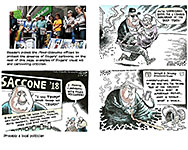
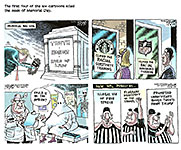
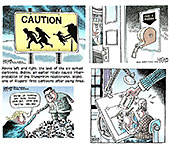

1.jpg)
2.jpg)
3.jpg)
4.jpg)
5.jpg)

